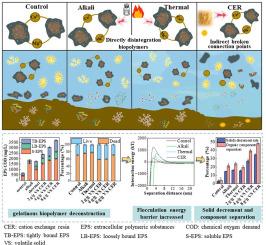各种驱动力对下水道沉积物有机/无机成分分离的综合认识:分离途径和热力学演化
IF 6.3
2区 环境科学与生态学
Q1 ENVIRONMENTAL SCIENCES
引用次数: 0
摘要
随着立法的发展,有机和无机成分分离已成为污水处理的首要要求,但相关技术报道较少,驱动机制尚不清楚。本研究研究了生物聚合物在水解和组分分离过程中的直接崩解和连接点的间接断裂。提出了碱法、热法和阳离子交换法三种典型的污水底泥处理方法,分别代表了化学水解、物理水解和创新性阳离子桥接断裂的水解驱动力。结果表明:碱性、热交换和阳离子交换处理对下水道底泥的有机和无机分离率分别达到21.26%、23.80%和19.56% ~ 48.0%,而对照为4.43%。蛋白质的二级结构被破坏,从α-螺旋转变为β-螺旋和随机螺旋。同时,许多生物聚合物从固体释放到液相。从热力学角度看,下水道沉积物沉积受扩展Derjaguin-Landau-Verwey-Overbeek理论描述的短程界面相互作用控制。此外,有机和无机组分的分离与热力学参数呈正相关(Corr = 0.87),突出了各种驱动力的鲁棒性。与对照组相比,絮凝能垒(碱性)为2.40倍,(热)为1.60倍,(阳离子交换)为4.02-4.97倍。研究结果揭示了沉积物组分分离中凝胶状生物聚合物直接崩解与组分连接位点间接断裂的差异,填补了了解沉积物生物聚合物崩解和分子间连接断裂具体机制的关键空白。本文章由计算机程序翻译,如有差异,请以英文原文为准。

Comprehensive insights into the organic/inorganic composition separation of sewer sediment by various driving forces: Separation pathway and thermodynamic evolution
With the legislative development, the organic and inorganic composition separation has become the primary requirement for sewer sediment disposal, however the relevant technology has been rarely reported and the driving mechanism was still unclear. In this study, direct disintegration of biopolymers and indirect broken of connection point were investigated on the hydrolysis and component separation. Three typical sewer sediment treatment approaches, i.e., alkaline, thermal and cation exchange treatments were proposed, which represented the hydrolysis-driving forces of chemical hydrolysis, physical hydrolysis and innovative cation bridging breakage. The results showed that the organic and inorganic separation rates of sewer sediment driven by alkaline, thermal and cation exchange treatments reached 21.26 %, 23.80 %, and 19.56 %-48.0 %, respectively, compared to 4.43 % in control. The secondary structure of proteins was disrupted, transitioning from α-helix to β-turn and random coil. Meanwhile, much biopolymers were released from solid to the liquid phase. From thermodynamic perspective, sewer sediment deposition was controlled by short-range interfacial interactions described by extended Derjaguin-Landau-Verwey-Overbeek theory. Additionally, the separation of organic and inorganic components was positively correlated with the thermodynamic parameters (Corr = 0.87), highlighted the robustness of various driving forces. And the flocculation energy barriers were 2.40 (alkaline), 1.60 times (thermal), and 4.02–4.97 times (cation exchange) compared to control group. The findings revealed the contrition difference of direct disintegration of gelatinous biopolymers and indirect breakage of composition connection sites in sediment composition separation, filling the critical gaps in understanding the specific mechanisms of sediment biopolymer disintegration and intermolecular connection breakage.
求助全文
通过发布文献求助,成功后即可免费获取论文全文。
去求助
来源期刊

Journal of Environmental Sciences-china
环境科学-环境科学
CiteScore
13.70
自引率
0.00%
发文量
6354
审稿时长
2.6 months
期刊介绍:
The Journal of Environmental Sciences is an international journal started in 1989. The journal is devoted to publish original, peer-reviewed research papers on main aspects of environmental sciences, such as environmental chemistry, environmental biology, ecology, geosciences and environmental physics. Appropriate subjects include basic and applied research on atmospheric, terrestrial and aquatic environments, pollution control and abatement technology, conservation of natural resources, environmental health and toxicology. Announcements of international environmental science meetings and other recent information are also included.
 求助内容:
求助内容: 应助结果提醒方式:
应助结果提醒方式:


